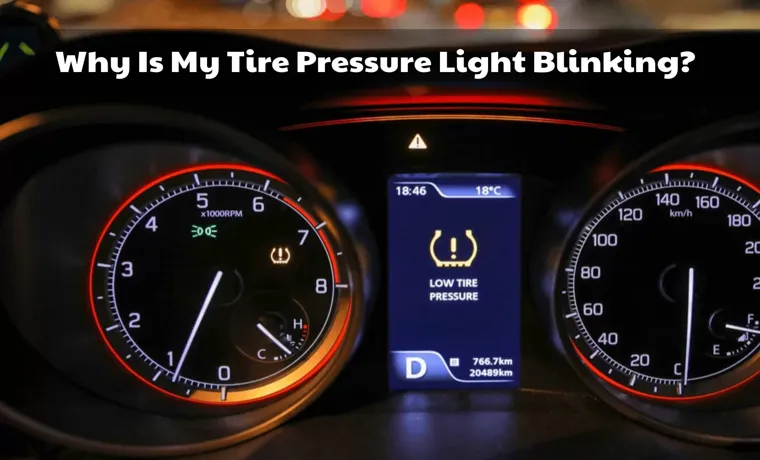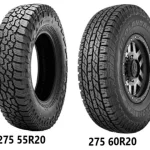Have you recently filled your Toyota’s tires, but the tire pressure light is still on? It can be frustrating to see your efforts go to waste. But don’t worry, you’re not alone. There could be various reasons why the tire pressure light is still on, even after filling your tires to the recommended pressure level.
One possible reason could be that there’s a leak in one of your tires. Even a small leak can cause the tire pressure to drop, triggering the warning light. Another reason could be that the tire pressure sensors are malfunctioning.
In this case, you may need to get them checked or replaced. It’s also important to note that tire pressure fluctuates with temperature changes. So if you filled your tires in cold weather, and then the weather warmed up, the tire pressure may have increased, causing the light to go on.
Lastly, make sure you’ve checked the spare tire as well, as it also has a tire pressure sensor. In short, there could be various reasons why the tire pressure light is still on. If you’ve checked all the tires, and they’re at the recommended pressure level, then it may be time to take your Toyota to a mechanic for further inspection.
Table of Contents
Understanding Tire Pressure Light
If you’re wondering why your tire pressure light is still on after filling your tires on a Toyota, there could be a few reasons. Firstly, it’s important to make sure you’re filling your tires to the correct pressure level as recommended by your vehicle’s manufacturer. If you’ve done this and the light is still on, there could be an issue with the sensors in your tires or the system itself.
It’s also possible that there’s a slow leak in one of your tires that needs to be addressed. Even if the tires seem fully inflated, a small leak can cause the pressure to drop significantly over time. It’s best to check your tires regularly to ensure they’re at the correct pressure and have them inspected by a professional if you’re experiencing ongoing issues with your TPMS light.
How Tire Pressure Monitoring System Works
Tire Pressure Monitoring System Have you ever been driving and noticed a light on your dashboard indicating low tire pressure? That pesky little light is part of your car’s Tire Pressure Monitoring System (TPMS). The TPMS is a safety feature found in modern vehicles that continuously monitors the air pressure in your tires. When the air pressure drops below the recommended level, the TPMS alerts the driver via a warning light on the dashboard.
This is important as underinflated tires can cause a host of problems, including decreased fuel efficiency, poor road handling, and in extreme cases, blowouts. By keeping your tires properly inflated, you not only ensure your safety but can also save money on fuel costs. The TPMS has sensors located in each tire, which transmit data wirelessly to the onboard computer.
This information is then analyzed to determine if the tire pressure is within a safe range. So, next time you see the tire pressure light on your dashboard, remember that your car is reminding you to check your tire pressure and keep yourself safe on the road.

Reasons Why Tire Pressure Light Stays On
If you’ve ever had your tire pressure warning light come on and not know what to do about it, don’t worry, you’re not alone. Tire pressure monitoring systems (TPMS) can be a tricky and frustrating feature to figure out, but understanding why your tire pressure light stays on can be a lifesaver in the long run. One common reason for the light staying on is a low tire pressure.
If your tires aren’t adequately inflated, it can cause incorrect pressure readings on your system, ultimately leading to the light staying on. Another cause could be a faulty sensor within the TPMS, which isn’t uncommon as they can malfunction over time. Lastly, it could be simple user error- forgetting to reset the system after filling your tires to the recommended pressure levels.
Regardless, making sure your tire pressure is correct not only keeps you safe but also extends the life of your tires, and resolving the issue will ensure a stress-free driving experience.
Steps to Reset the Tire Pressure Light
If you recently filled your tires with air and the tire pressure light on your Toyota is still on, there are a few steps you can take to reset it. First, make sure all tires are properly inflated to the recommended PSI for your vehicle. Then, locate the tire pressure monitoring system reset button, which is often near the steering wheel or under the dashboard.
Press and hold the button until the light on the dashboard blinks three times. Release the button and wait for the light to turn off. If the light does not turn off, it may be necessary to drive the car at least 20 miles per hour for several minutes until the system resets.
Remember, keeping your tires properly inflated is not only important for your safety, but also for improving fuel efficiency and prolonging the life of your tires.
Checking Tire Pressure and Inflating Them
It’s important to check your tire pressure regularly, as underinflated tires can lead to increased wear and tear, decreased fuel efficiency, and even unsafe driving conditions. If your tire pressure light comes on, don’t ignore it! Follow these steps to reset the light and ensure that your tires are properly inflated. First, make sure that your tires are cool and the vehicle is in park.
Then, locate the tire pressure monitoring system reset button, which is usually located under the steering wheel or dashboard. Press and hold the button until the light turns off and then release the button. Finally, check your tire pressure using a tire gauge and inflate as needed to the recommended level.
By taking these steps, you can ensure that your tires are always in good condition and that you are driving safely on the road.
Locating Tire Pressure Monitoring System Reset Button
If you’ve ever had your tire pressure light come on, you know how important it is to reset it. Many vehicles have a Tire Pressure Monitoring System (TPMS) that detects when the pressure in one or more tires is low. In order to reset the TPMS light, you first need to locate the reset button.
This button can be found in a variety of places depending on the make and model of your vehicle. Some buttons are located near the steering wheel, while others may be found on the dashboard or in the glove box. Once you have found the reset button, the process for resetting the TPMS light is fairly simple.
Start by making sure your tires are properly inflated to the recommended PSI. Then, press and hold the reset button until the TPMS light blinks a few times. Release the button and wait for the light to turn off.
It’s important to note that the process may vary slightly depending on your vehicle, so always consult your owner’s manual for specific instructions. By following these steps, you can reset your TPMS light and ensure that your tires are properly inflated for optimal performance and safety on the road.
Resetting the Tire Pressure Monitoring System
If you see the tire pressure light on your dashboard, don’t panic! It’s a common issue that can easily be resolved by resetting your Tire Pressure Monitoring System (TPMS). First, ensure that all tires are properly inflated to the manufacturer’s recommended PSI. Then, turn on your vehicle’s ignition without starting the engine and press and hold the TPMS reset button until the indicator light blinks three times.
Release the button and start your engine, letting it run for a few minutes to allow the TPMS to recalibrate. If the light is still on after following these steps, there may be a more significant issue with your tires that needs to be addressed. Regularly checking and maintaining your tire pressure can help prevent this from happening in the future.
Importance of Correct Tire Pressure
If you’re wondering why your tire pressure light is still on after filling your tires on a Toyota, it could be due to a variety of reasons. One of the most important aspects of keeping your car in top shape is to maintain your tire pressure at the correct level. This is because driving with low tire pressure can significantly impact your vehicle’s handling, fuel efficiency, and safety.
When tire pressure drops below the recommended level, it can cause unnecessary wear and tear on the tires, leading to increased risk of blowouts and accidents. On the other hand, overinflated tires can make your car unstable and reduce the amount of grip on the road. So, if you notice your tire pressure light is on even after filling your tires, it could be a sign of a leak, puncture, or malfunctioning tire sensors.
A certified mechanic can help you identify the root cause of the issue and make the necessary repairs to ensure your car is safe and roadworthy. Remember, it’s always better to err on the side of caution when it comes to your vehicle’s tire pressure.
Improving Fuel Efficiency and Safety
Correct tire pressure is vital to ensure both fuel efficiency and safety while driving. When tires are underinflated, the engine has to work harder to move the car, which leads to increased fuel consumption and higher emissions, costing you more money and harming the environment. Additionally, underinflated tires can affect handling and braking, increasing the risk of accidents.
On the other hand, overinflated tires reduce the contact with the road, leading to reduced grip and traction, which can also lead to accidents. Therefore, it is recommended to check your tire pressure monthly and keep them inflated to the recommended level, which can be found in your vehicle owner’s manual or on the tire sidewall. Invest a few minutes each month to check your tire pressure, and you’ll save money and drive safer on the road.
Lessening Tire Wear
Maintaining the correct tire pressure is essential in keeping your tires in good condition and lessening tire wear. Incorrect tire pressure can lead to a host of problems, including uneven tread wear, reduced fuel efficiency, and poor handling. Overinflated tires can cause the center of the tire to wear out faster, while underinflated tires can cause the edges of the tire to wear out faster.
On top of that, underinflated tires have a greater chance of overheating, which could lead to a sudden blowout. Therefore, it is crucial to regularly check and adjust tire pressure as needed to ensure that your tires are operating at their optimal performance. By doing so, you’ll not only get more mileage out of your tires, but you’ll also improve your vehicle’s safety and handling on the road.
Wrapping Up
If you’ve ever experienced the frustrating dilemma of your tire pressure light still being on after filling your tires on your Toyota, don’t worry, you’re not alone. While the simple solution may be to assume that you didn’t add enough air to your tires, sometimes there can be other factors at play. One possibility is that your torque could be off, causing the sensor to still register as low pressure even after filling up.
Another possibility is that there could be a problem with the sensor itself, such as damage or malfunctioning. In either case, it’s best to take your vehicle to a trusted mechanic to diagnose and fix the issue to avoid any potential safety hazards. Remember to always keep an eye on your tire pressure and address any warning signs quickly to prevent any issues that can lead to expensive repairs down the road.
Conclusion
Well, much like a persistent hangover after a night of indulgence, your tire pressure light may still be on after filling your tires because it simply needs time to reset and recover. Alternatively, there could be a pesky sensor or valve issue lurking beneath the surface, reminding us that sometimes even the most seemingly insignificant details can have a major impact on our driving experience. So, keep on top of your tire pressure maintenance, and don’t be afraid to seek professional assistance if the problem persists.
After all, a smooth ride is always worth the effort!”
FAQs
Why did my tire pressure light come on in my Toyota?
Your tire pressure light may have come on in your Toyota because your tire pressure is low.
How do I reset my tire pressure light after filling my tires in my Toyota?
To reset your tire pressure light after filling your tires in your Toyota, drive your car for a few miles until the light turns off automatically. If it doesn’t turn off, consult your owner’s manual for specific instructions on how to reset the light.
Can a small puncture cause my tire pressure light to come on in my Toyota?
Yes, a small puncture can cause your tire pressure light to come on in your Toyota because it may cause a slow leak in your tire.
What should I do if my tire pressure light comes on again after I’ve filled my tires in my Toyota?
If your tire pressure light comes on again after you’ve filled your tires in your Toyota, you may have a leak or a problem with your tire pressure monitoring system. Check your tire pressure and consult a mechanic if necessary.
Can extreme temperatures cause my tire pressure light to come on in my Toyota?
Yes, extreme temperatures can cause your tire pressure light to come on in your Toyota because the air pressure in your tires can fluctuate with temperature changes.
What is the recommended tire pressure for my Toyota?
The recommended tire pressure for your Toyota can be found in your owner’s manual or on the sticker located on the driver’s side door jamb.
How often should I check my tire pressure in my Toyota?
It is recommended to check your tire pressure in your Toyota at least once a month or before a long trip.



